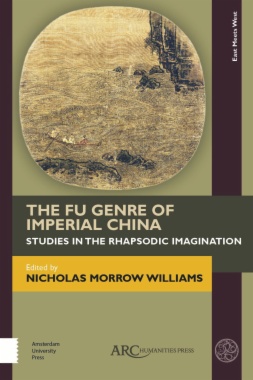This is the first book in English to examine the fu, one of China’s oldest and culturally central literary forms, from its origins up to the late imperial era. Fu poems are highly revealing sources for understanding the culture, society, and politics of their periods, and in this volume eleven essays by prominent scholars treat the fu from four major perspectives: its original use in court recitation; as a poetic genre with distinctive formal features; as a vehicle of philosophical inquiry; and as a major mode of political expression.
- Front Cover
- Front matter
- Half-title
- Series information
- Title page
- Copyright information
- Table of contents
- Body
- Chapter 1. Introduction: The Rhapsodic Imagination
- Part One. Recitation and Display
- Chapter 2. The Origins of the Term “Fu” as a Literary Genre of Recitation
- The Puchen .. Theory: “Directly Displaying”
- Challenging the Puchen Theory
- The Recitation Theory
- The Liu shi and the Recitation Theory
- An Etymological Approach by Jia Jinhua
- Another Etymological Approach by Chen Yunzhu
- Fu as a Literary Genre of Recitation61
- Chapter 3. Into the New Realm of Belles Lettres
- Part Two. Lyricism and Form
- Chapter 4. The Assimilation and Dissimilation of Fu and Shi Poetry up to the Tang Dynasty
- The Pre-Qin Period and Han Dynasty
- “Fu Is an Outflow of the Ancient Songs”: Canonizing a Genre Through Assimilation
- “To Recite without Singing Is Called Fu”: Establishing Self-Identity through Dissimilation
- The Wei, Jin, and Northern and Southern Dynasties
- Shi and Fu Pieces with the Same Title
- Lyricization of the Fu in the Southern Dynasties
- The “Fu-icization” of Verse and the Rise of the Fu de ti
- Conclusion
- Chapter 5. Xu Wei’s Early Modern Rhapsodies: Catalogue and Critique, Lyricism and Logic
- Dreams of Good Taste: “What Others Ignore, I Alone Study in Detail”
- The Garden of Metaphors: Xu Wei’s “Rhapsody on (Poems about) Peonies”
- Evoking the Self as Aesthetic Object: Evolution of the Yongwu Mode
- Influence
- Conclusion
- Part Three. Philosophy and Dialogue
- Chapter 6. The Metaphysical Rhapsody of the Six Dynasties
- The Rise of the Metaphysical Rhapsody: In Search of Nonbeing
- The Buddhist Conquest of the Metaphysical Rhapsody
- Coda
- Chapter 7. Argumentation and Generic Change in the Mid-Tang Fu
- Li Guan’s “Ku yu fu”
- The Interplay of Modes: Readings of “Ku yu fu”
- Textual Affinities
- Further Lexical Considerations
- Rhyme
- Reconsidering the Fu/Shelun Relationship
- Conclusions
- Part Four. Critique and Protest
- Chapter 8. The Hidden Message of Zhang Heng’s “Contemplating the Mystery”
- The Imaginary Journey in the “Contemplating the Mystery”
- Comparing the Five Imaginary Journey Poems
- The Journeys to the Four Cardinal Points
- Conclusions
- Chapter 9. A New Discourse on “Lament for the South” in the Fu of the Ming–Qing Transition1
- The Collective Understanding of “Lament for the South”
- The Yu Xin Controversy
- “What Soil Remains Untainted?”
- Back matter

